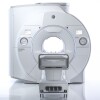Healthcare Chronicles February
February 26, 2009

Healthcare Chronicles
by Paul J. Mirabella
Diagnostic Imaging's Technological Evolution - Diagnostic Imaging has undergone significant changes over the last four decades. By following established steps, those innovations can find more receptive clinicians, government and private payor organizations.
Clinically Relevant Leadership Technology - Often, an "upgrade" is introduced because it enables performance at "higher specifications" than the preceding platform without really solving a clinical problem. In the late 1980s, slip rings were introduced to "scan faster" without considering the required increase in X-ray Tube power and detector efficiency. The resulting earliest machines rotated faster . . . but in the same anatomical location until they had provided enough power to produce a decent image. More recent examples abound from the CT slice wars to the Tesla envy driving higher field strength MR systems, when the only relevant questions should be (CT example), "does this technology enable higher diagnostic confidence in the breath-hold time of a sick patient?" Or (MR example),"does the additional resolution enable either more rapid acquisition and/or quantifiably better diagnosis."
Differential Diagnostic Value -Diagnostic imaging technology must produce a unique anatomical image or provide some differential diagnostic information which cannot be obtained using existing technologies. Lonnie Edelheiht, Ph. D. (formerly, Senior VP, GE's Global Research Center) and Herb Kressel, M.D. (Editor, Radiology) taught many of us the importance of what they deemed the "magic picture theory" which stated that all DI technologies would languish until they met these simple clinical criteria for acceptance.
Indisputable Clinical Appropriateness - Nothing kills the clinical acceptance by patients, payors and purchasers as fast as headlines in national newspapers that make referring physicians feel like they are unnecessarily driving up the cost of health care by ordering an exam that is currently being highlighted for abuse. It is crucial that relevant data backs the need for the use of specific technologies.
Endorsement of Thought Leaders - "Who is using it and where can I observe the procedure for myself, without feeling like I'm attending a sales pitch?" is a common question by perspective buyers. While many non-academic sites offer excellent and clinically credible demonstrations for new technology, if the question isn't answered by an academic luminary, well-respected for their reputation, stature in the appropriate societies, publications and above all else, integrity and objectivity ...it's going to be a long road to acceptance.
Diagnostic Imaging's Technological Evolution - Diagnostic Imaging has undergone significant changes over the last four decades. By following established steps, those innovations can find more receptive clinicians, government and private payor organizations.
Clinically Relevant Leadership Technology - Often, an "upgrade" is introduced because it enables performance at "higher specifications" than the preceding platform without really solving a clinical problem. In the late 1980s, slip rings were introduced to "scan faster" without considering the required increase in X-ray Tube power and detector efficiency. The resulting earliest machines rotated faster . . . but in the same anatomical location until they had provided enough power to produce a decent image. More recent examples abound from the CT slice wars to the Tesla envy driving higher field strength MR systems, when the only relevant questions should be (CT example), "does this technology enable higher diagnostic confidence in the breath-hold time of a sick patient?" Or (MR example),"does the additional resolution enable either more rapid acquisition and/or quantifiably better diagnosis."
Differential Diagnostic Value -Diagnostic imaging technology must produce a unique anatomical image or provide some differential diagnostic information which cannot be obtained using existing technologies. Lonnie Edelheiht, Ph. D. (formerly, Senior VP, GE's Global Research Center) and Herb Kressel, M.D. (Editor, Radiology) taught many of us the importance of what they deemed the "magic picture theory" which stated that all DI technologies would languish until they met these simple clinical criteria for acceptance.
Indisputable Clinical Appropriateness - Nothing kills the clinical acceptance by patients, payors and purchasers as fast as headlines in national newspapers that make referring physicians feel like they are unnecessarily driving up the cost of health care by ordering an exam that is currently being highlighted for abuse. It is crucial that relevant data backs the need for the use of specific technologies.
Endorsement of Thought Leaders - "Who is using it and where can I observe the procedure for myself, without feeling like I'm attending a sales pitch?" is a common question by perspective buyers. While many non-academic sites offer excellent and clinically credible demonstrations for new technology, if the question isn't answered by an academic luminary, well-respected for their reputation, stature in the appropriate societies, publications and above all else, integrity and objectivity ...it's going to be a long road to acceptance.
1(current)














